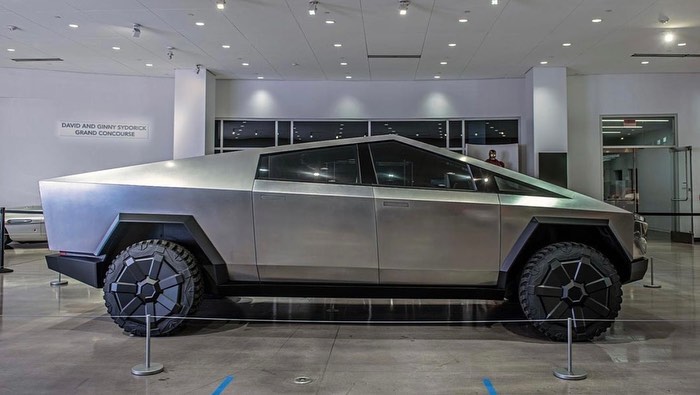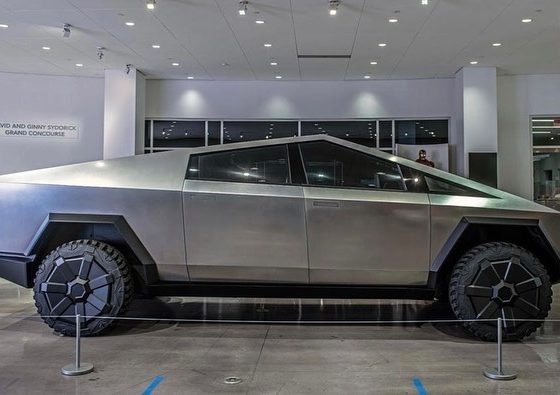

News
Tesla Cybertruck to be ‘Elon Musk’s first disaster,’ according to Jim Cramer
Since November 2019, arguably the most frequently-discussed electric vehicle coming to the market has been the Tesla Cybertruck. The first pickup from Elon Musk’s electric car company shocked nearly everyone who tuned in to the live event streamed nearly two years ago as the Tesla frontman and the company’s Chief Designer Franz von Holzhausen rolled out the Cyberpunk-inspired pickup onto the stage in Hawthorne, California. However, despite having over 1.2 million pre-orders thus far, the truck is not making everyone turn their heads and throw $100 down to reserve one. One of those people is Tesla investor and Musk fan Jim Cramer, who said that the truck is bound to be Musk’s “first disaster.”
While fielding questions regarding Tesla’s AI Day last week during an interview on Wall Street, Cramer averted commenting very much on the Tesla Bot that Elon Musk said the company would bring in 2022 in a prototype form and instead focused on the Cybertruck. His comments were unfavorable toward the all-electric pickup, with Cramer recommending that consumers opt for a more traditional pickup style in the Ford F-150 Lightning as the Cybertruck is “ugly.”
“I saw the actual pickup truck,” Cramer said when speaking about the Cybertruck. “Go buy an F-150. I mean, this thing is not just ugly…You have got to love Tesla to get this thing,” Cramer added.
There is no doubt that the Cybertruck has an unorthodox and “polarizing” look, as many people have described the truck. Still, this was the point of the design. One of the first portions of Musk’s presentation in November 2019 had to do with the traditional automakers and how their pickups stood apart from others. Taking manufacturer badges away from the truck makes it more difficult to tell each model apart. The traditional design has been broken down to a rectangular driver’s cabin and a bed, with relatively the same shapes and angles shared amongst the major pickup truck designs in the United States.
This is where Tesla decided that an orthodox pickup may not be the best option. Instead, Tesla went with a futuristic design, covered in ultra-strength stainless steel alloy and equipped with resilient glass and, potentially, solar panels on the tonneau for additional range.
Tesla Cybertruck’s Solar Panel Tonneau Cover comes to life in new patent
Cramer is still a Tesla supporter, he says, especially as the automaker has avoided massive failures with its product. Specifically mentioning the recent Chevrolet Bolt EV recall due to faulty batteries, Cramer believes Tesla is one of the major players in the sector, especially in terms of autonomous driving. “I still like Tesla because I think it’s been unfair the way their autonomous driving has been handled. There are many more accidents from drunk drivers. But I recognize…I think this pickup truck is going to be a disaster, his first disaster.”
Interestingly, Cramer and Musk share a similar but not an identical point of view on the Cybertruck. While Cramer is undoubtedly convinced the Cybertruck will fall flat, Musk has stated in the past that the truck could be a flop due to its unfamiliar design. However, 1.2 million reservations for the truck say differently.
The Ford F-150 Lightning will be the company’s second EV to the market, following the Mustang Mach-E. The truck has already amassed an impressive 120,000 pre-orders, according to Ford’s Q2 2021 Earnings Call. Sporting a traditional pickup design, the two options on the market may be the perfect recipe for accelerating the transition to sustainable energy as the traditional and unorthodox designs should cater to consumers and what they’re looking for in a new vehicle.
Don’t hesitate to contact us with tips! Email us at tips@teslarati.com, or you can email me directly at joey@teslarati.com.

News
Tesla FSD fleet is nearing 7 billion total miles, including 2.5 billion city miles
As can be seen on Tesla’s official FSD webpage, vehicles equipped with the system have now navigated over 6.99 billion miles.

Tesla’s Full Self-Driving (Supervised) fleet is closing in on almost 7 billion total miles driven, as per data posted by the company on its official FSD webpage.
These figures hint at the massive scale of data fueling Tesla’s rapid FSD improvements, which have been quite notable as of late.
FSD mileage milestones
As can be seen on Tesla’s official FSD webpage, vehicles equipped with the system have now navigated over 6.99 billion miles. Tesla owner and avid FSD tester Whole Mars Catalog also shared a screenshot indicating that from the nearly 7 billion miles traveled by the FSD fleet, more than 2.5 billion miles were driven inside cities.
City miles are particularly valuable for complex urban scenarios like unprotected turns, pedestrian interactions, and traffic lights. This is also the difference-maker for FSD, as only complex solutions, such as Waymo’s self-driving taxis, operate similarly on inner-city streets. And even then, incidents such as the San Francisco blackouts have proven challenging for sensor-rich vehicles like Waymos.
Tesla’s data edge
Tesla has a number of advantages in the autonomous vehicle sector, one of which is the size of its fleet and the number of vehicles training FSD on real-world roads. Tesla’s nearly 7 billion FSD miles then allow the company to roll out updates that make its vehicles behave like they are being driven by experienced drivers, even if they are operating on their own.
So notable are Tesla’s improvements to FSD that NVIDIA Director of Robotics Jim Fan, after experiencing FSD v14, noted that the system is the first AI that passes what he described as a “Physical Turing Test.”
“Despite knowing exactly how robot learning works, I still find it magical watching the steering wheel turn by itself. First it feels surreal, next it becomes routine. Then, like the smartphone, taking it away actively hurts. This is how humanity gets rewired and glued to god-like technologies,” Fan wrote in a post on X.
News
Tesla starts showing how FSD will change lives in Europe
Local officials tested the system on narrow country roads and were impressed by FSD’s smooth, human-like driving, with some calling the service a game-changer for everyday life in areas that are far from urban centers.

Tesla has launched Europe’s first public shuttle service using Full Self-Driving (Supervised) in the rural Eifelkreis Bitburg-Prüm region of Germany, demonstrating how the technology can restore independence and mobility for people who struggle with limited transport options.
Local officials tested the system on narrow country roads and were impressed by FSD’s smooth, human-like driving, with some calling the service a game-changer for everyday life in areas that are far from urban centers.
Officials see real impact on rural residents
Arzfeld Mayor Johannes Kuhl and District Administrator Andreas Kruppert personally tested the Tesla shuttle service. This allowed them to see just how well FSD navigated winding lanes and rural roads confidently. Kruppert said, “Autonomous driving sounds like science fiction to many, but we simply see here that it works totally well in rural regions too.” Kuhl, for his part, also noted that FSD “feels like a very experienced driver.”
The pilot complements the area’s “Citizen Bus” program, which provides on-demand rides for elderly residents who can no longer drive themselves. Tesla Europe shared a video of a demonstration of the service, highlighting how FSD gives people their freedom back, even in places where public transport is not as prevalent.
What the Ministry for Economic Affairs and Transport says
Rhineland-Palatinate’s Minister Daniela Schmitt supported the project, praising the collaboration that made this “first of its kind in Europe” possible. As per the ministry, the rural rollout for the service shows FSD’s potential beyond major cities, and it delivers tangible benefits like grocery runs, doctor visits, and social connections for isolated residents.
“Reliable and flexible mobility is especially vital in rural areas. With the launch of a shuttle service using self-driving vehicles (FSD supervised) by Tesla in the Eifelkreis Bitburg-Prüm, an innovative pilot project is now getting underway that complements local community bus services. It is the first project of its kind in Europe.
“The result is a real gain for rural mobility: greater accessibility, more flexibility and tangible benefits for everyday life. A strong signal for innovation, cooperation and future-oriented mobility beyond urban centers,” the ministry wrote in a LinkedIn post.
News
Tesla China quietly posts Robotaxi-related job listing
Tesla China is currently seeking a Low Voltage Electrical Engineer to work on circuit board design for the company’s autonomous vehicles.

Tesla has posted a new job listing in Shanghai explicitly tied to its Robotaxi program, fueling speculation that the company is preparing to launch its dedicated autonomous ride-hailing service in China.
As noted in the listing, Tesla China is currently seeking a Low Voltage Electrical Engineer to work on circuit board design for the company’s autonomous vehicles.
Robotaxi-specific role
The listing, which was shared on social media platform X by industry watcher @tslaming, suggested that Tesla China is looking to fill the role urgently. The job listing itself specifically mentions that the person hired for the role will be working on the Low Voltage Hardware team, which would design the circuit boards that would serve as the nervous system of the Robotaxi.
Key tasks for the role, as indicated in the job listing, include collaboration with PCB layout, firmware, mechanical, program management, and validation teams, among other responsibilities. The role is based in Shanghai.
China Robotaxi launch
China represents a massive potential market for robotaxis, with its dense urban centers and supportive policies in select cities. Tesla has limited permission to roll out FSD in the country, though despite this, its vehicles have been hailed as among the best in the market when it comes to autonomous features. So far, at least, it appears that China supports Tesla’s FSD and Robotaxi rollout.
This was hinted at in November, when Tesla brought the Cybercab to the 8th China International Import Expo (CIIE) in Shanghai, marking the first time that the autonomous two-seater was brought to the Asia-Pacific region. The vehicle, despite not having a release date in China, received a significant amount of interest among the event’s attendees.








